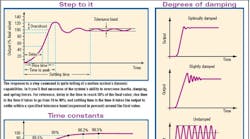Control systems are often characterized in terms of how they respond to a step function. In the case of a motion system, the “step” is usually a command to change position or speed.
For comparative purposes, the dynamics of a step response may be summarized using five basic parameters — delay, rise time, time to peak, overshoot, and settling time. These factors are indicative of the inertia, damping, and spring forces present in most systems, as well as the dynamic limitations of the controller, drive, motor, and mechanical components themselves.
Often, one of the major challenges in designing motion systems is determining how much deviation in the step response is acceptable for a given application. Once that’s established, it is much easier to analyze and evaluate system performance.
Questions & Answers
Q: How do time constants relate to settling time?
A: Both are a measure of response speed. Time constants gauge how quickly a response builds, while settling time tells you how long it takes the output (in the event of oscillations) to settle within a given band around the final value. The most general term to describe response speed is “hertz” — the maximum frequency at which the system can respond without exceeding a given amount of lag between the input and output.
Q: What are the sources of inertia, damping, and spring force?
A: System inertia includes rotor and load inertia; damping (a resisting torque proportional to speed) includes friction, drag, and motor cogging; spring forces originate in the magnetodynamics of the motor and in the twisting of couplings, shafts, and other mechanical components.
Q: Is there a way to improve response electronically?
A: Yes, by varying the damping and gain coefficients in the controller. The higher the gain, the “stiffer” the system and the faster its response. Increasing the amount of damping can also improve speed because it reduces the tendency to ring or hunt.

